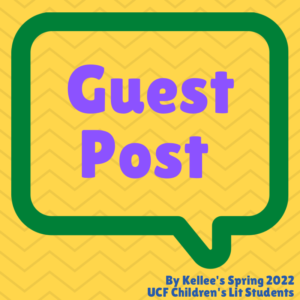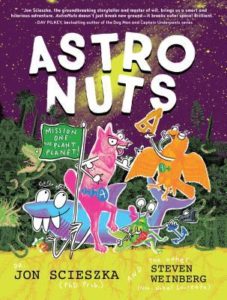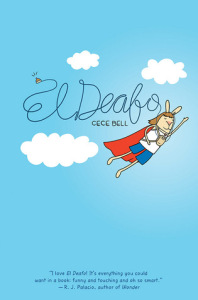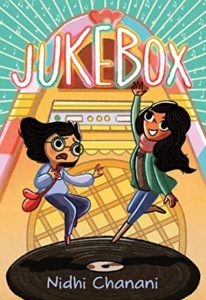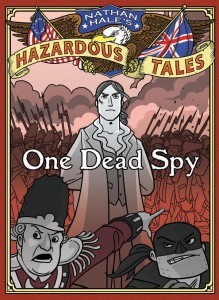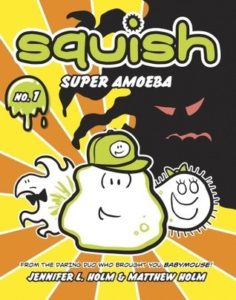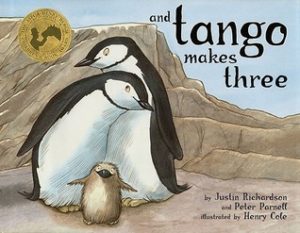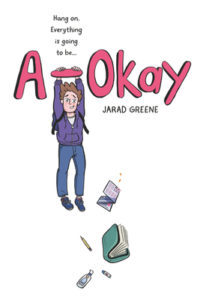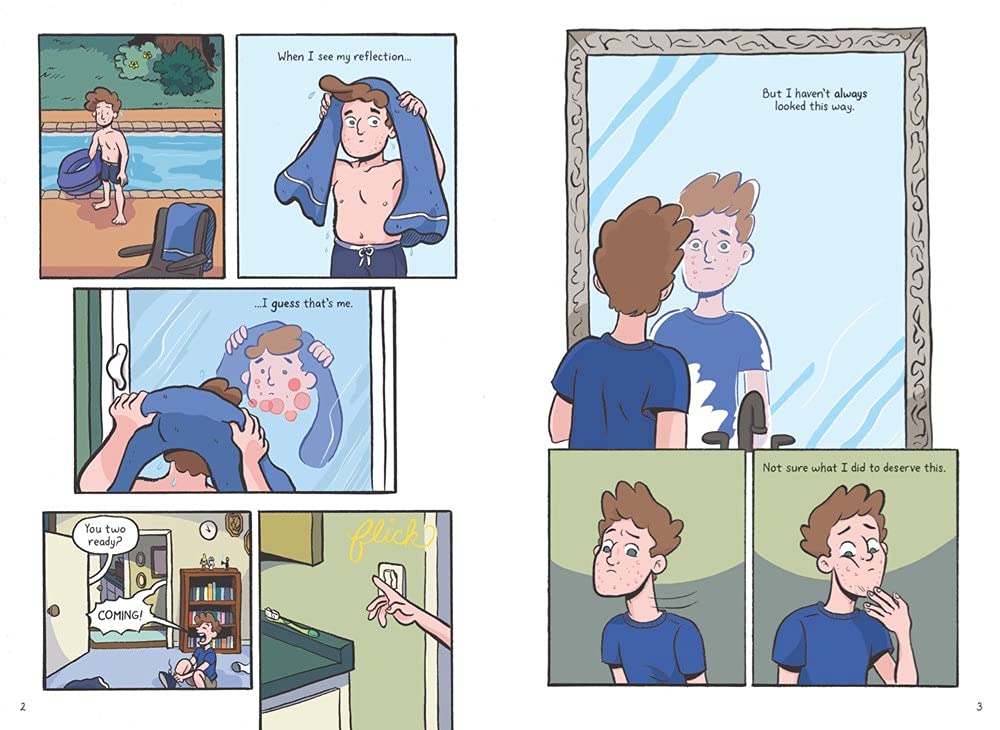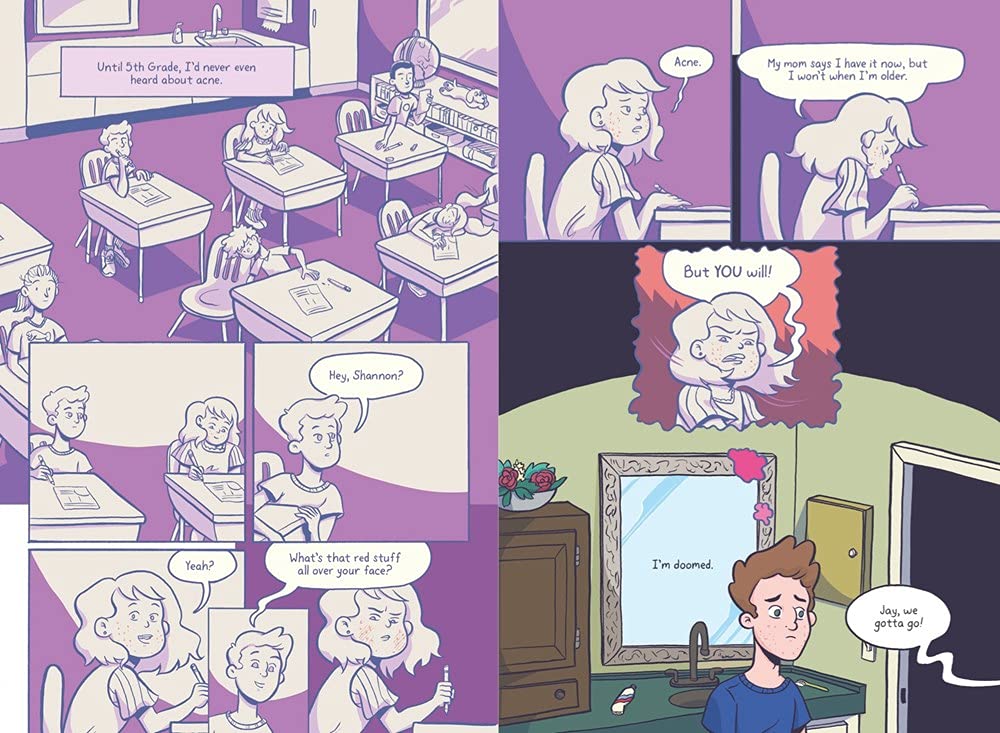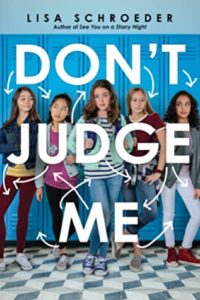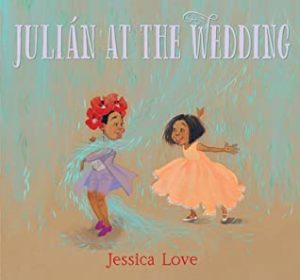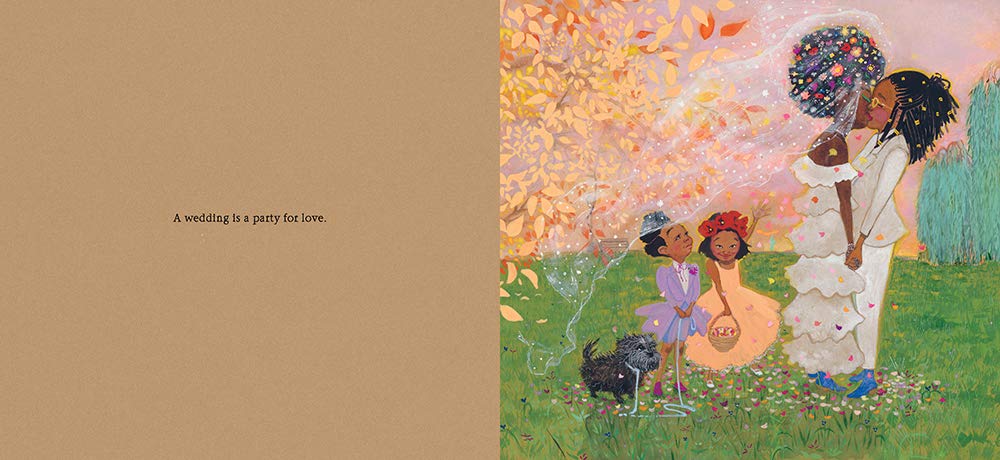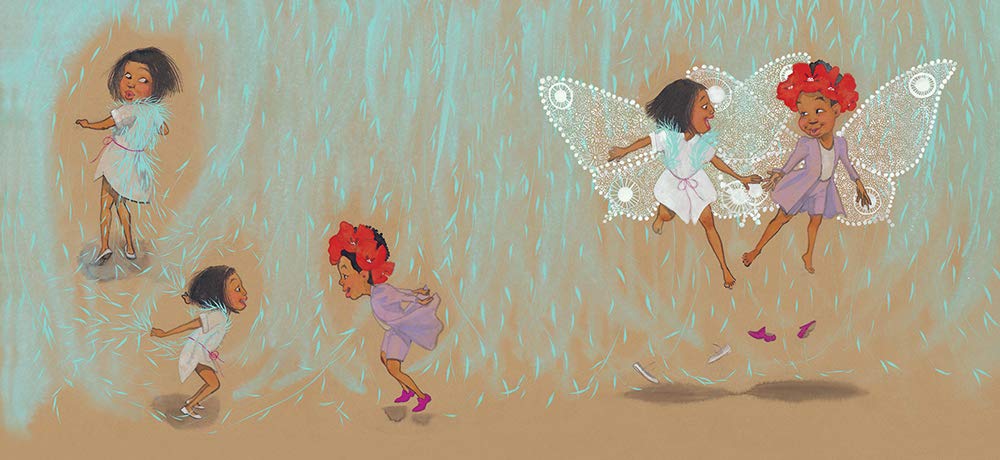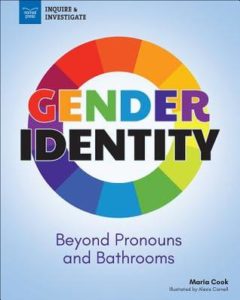One of the assignments during my Spring Children’s Literature course at UCF was creating a mini-teaching guide for the books we read for book clubs. We started with picture books for practice then students created them in their book clubs each week.
Today, I am happy to share the classroom uses and discussion questions found by my UCF Elementary Education students about these graphic novels.
AstroNuts Mission One: The Plant Planet
Author: Jon Scieszka
Illustrator: Steven Weinberg
Published September 10th, 2019 by Chronicle Books
Summary: AstroWolf, LaserShark, SmartHawk, and StinkBug are animal astronauts that were sent on a mission to find a sustainable planet for humans to live on once we’ve ruined Earth. So off they rocket to the Plant Planet in the nose rocket! They must perform experiments to gather all the information needed to know if the planet would be able to sustain humans, Or do Plant Planet’s inhabitants have a different plan in store. This book uses real life science with a fun twist.
Teachers’ Tools for Navigation: This book would be great for teaching all about planet Earth, how to recycle, and how to protect the planet. Also, this book does a great job on putting a fun, zany twist on its characters that make this educational, engaging, and entertaining. These are all great things that students can look forward to when reading this book and are introduced to it, in the classroom.
In terms of interdisciplinary elements, we have discussed that the best subject that the book AstroNuts can be connected to is science. This book can be seen from many different angles when connected to science, but can be more specifically geared towards the knowledge of climate change, protecting one’s planet, and cell information (ex: plant cells).
Discussion Questions:
- Why do you think AstroWolf thought that he knew it all?
- Out of all the characters in AstroNuts (AstroWolf, LaserShark, etc.), which character do you think you could relate to the most? Explain.
- What could the AstroNuts have done differently in order to not anger the plants, when they first arrived on the planet?
- Which of the AstroNuts do you feel accomplished their goal for the mission? Why or why not?
- What aspects of the story do you see in our society when it comes to protecting our planet?
- How does this book inspire you when it talks about the environment and the ongoing topic of global warming?
- Which AstroNut do you think contributed the most to their mission? Explain.
- If you were an official for the NNASA how could you help prepare the AstroNuts for their next mission?
- If you were to draw Plant Planet, how would it look different from Earth. What types of things would be shown in your illustration? Explain.
Recommended For:
El Deafo
Author: Cece Bell
Published September 2nd, 2014 by Abrams Books
Summary: Starting at a new school is scary, even more so with a giant hearing aid strapped to your chest! At her old school, everyone in Cece’s class was deaf. Here she is different. She is sure the kids are staring at the Phonic Ear, the powerful aid that will help her hear her teacher. Too bad it also seems certain to repel potential friends.
Then Cece makes a startling discovery. With the Phonic Ear she can hear her teacher not just in the classroom, but anywhere her teacher is in school — in the hallway… in the teacher’s lounge… in the bathroom! This is power. Maybe even superpower! Cece is on her way to becoming El Deafo, Listener for All. But the funny thing about being a superhero is that it’s just another way of feeling different… and lonely. Can Cece channel her powers into finding the thing she wants most, a true friend?
Teachers’ Tools for Navigation: El Deafo teaches students about inclusivity which is something kids sometimes struggle with, and its books like this, that may just do the trick! This novel could also be a great choice as a book club book because it is a real-life story and could very well be a kids favorite. You can challenge your students, and have them create a piece of writing or art work that is inspired by this story, to show understanding. It’s great to have different books about kids with certain challenges, so other students can read and understand them better and see that they are not so different from other students, which is why it is encouraged that you to add this to your classroom library if it isn’t there already!
Discussion Questions:
- Based off of the cover of the book, what predictions do you have for the book?
- Why did Cece dislike the way Ginny spoke to her?
- How did Martha treat Cece when they first met?
- Do you think that Mike Miller was a good influence?
- Do you think that Cece missed out on a new opportunity to learn something new because she went into sign language school with a negative attitude?
- What would you have done if you were in Ceces’ shoes when the teacher slipped out of the classroom and your friends wanted you to listen for her?
- Why do you think the illustrator chose bunnies to be the characters?
- Based off of the cover of the book, what predictions do you have for the book?
- In what ways can you relate to Cece?
- Cece thought about herself as a superhero? What do you think makes a person a superhero?
- Why did Cece dislike the way Ginny spoke to her?
- How did Martha treat Cece when they first met?
- Do you think that Mike Miller was a good influence?
- Do you think that Cece missed out on a new opportunity to learn something new because she went into sign language school with a negative attitude?
- What would you have done if you were in Ceces’ shoes when the teacher slipped out of the classroom and your friends wanted you to listen for her?
- Why do you think the illustrator chose bunnies to be the characters?
- How did the illustration help you understand what is going on in the story?
Recommended For:
Jukebox
Author: Nidhi Chanani
Published June 22nd, 2021 by First Second
Summary: When her dad goes missing, Shahi and her cousin Naz discover a magical time traveling Jukebox and are transported throughout history. Traveling through time, Shahi and Naz race to find Gio and uncover the truth behind the Jukebox.
Teachers’ Tools for Navigation: This book is educational because it goes over important social issues and it has an engaging story line that will catch the reader’s attention.
Literature logs would allow students to make connections and critically think while they read the novel. The students can then revisit their notes before coming together for class discussions. Free writes allow students to get their real impressions of the book out. They are asked to write freely about the novel for a given amount of time. The absence of a prompt gives the students the chance to explore the aspects of the novel that stood out to them the most.
This book’s interdisciplinary concepts contain history, music and sexuality. Each record that plays brings you back to an event in history without giving too much information, this may lead readers to want to learn more about what was happening at different points of musical history and history in general. Along with this, there was mention of sexuality and the acceptance of it in their family. This can show the reader that it is okay to have a sexuality that isn’t heterosexuality.
Discussion Questions:
- Describe the relationship Shahi has with her parents and with Naz.
- What clues does the illustrator use to let the reader know what time period they are in?
- Why do you think Gio and Earl prefer to listen to music on records?
- Are you familiar with any of the music artists talked about in the book? If so, who and how did you learn about them? If not, who do you think would listen to and why?
- Do you think the store owner (Earl) was a bit selfish, if so, why do you think that?
- How does music influence your life?
- Do you think music and history go hand in hand to shape our communities today?
- Which historic time travel trip stood out to you the most and why?
- Describe one event in the book that stood out to you the most. Give your reasoning.
- Did you think that Shahi and Naz were ever going to find their father/ uncle? Why or why not?
- Why do you think the Jukebox was so important to Gio and Earl?
- Describe one time in history that was mentioned in the book that you would like to go back to.
Recommended For:
One Dead Spy
Author: Nathan Hale
Published August 1st, 2012 by Abrams Books
Summary: Nathan Hale is the first ever American spy during the Revolutionary War, who is to be hung by the British. Before the approval of the hanging a giant history book picks him up to go through the past events through Nathans’ point of view which made him a spy during the Revolutionary War, and what the future of the war will be.
Teachers’ Tools for Navigation: The book can be used with history and also when learning the time period the book is a good reference as far as word choice and vocabulary. It gives a good reference as far as seeing into the reality of the time period. It has great comedic relief and can be used to be an ice breaker when dealing with difficult things such as history, especially with our ELLs because it incorporates pictures and texts will allow them to make connections when reading and following along with pictures as well.
Discussion Questions:
- How does this book compare to the textbook as far as history? Does this text provide more of a reference or as pleasant reading?
- Knowing now that the main character is in reference to a real time activity, how does this change the pace and voice of the book?
- What connections can we make from the graphic novel to the text as we are reading the text?
- What can we infer from the textbook to foreshadow to happen in the graphic novel?
- Why couldn’t the British soldier hang Nathan at the beginning of the graphic novel?
- What were Nathan Hale’s famous last words?
- What other history figures are present in the book?
- How did Henry Knox get the cannons to General Wasington?
- What was the first American victory of the war? And who won it?
- How does the setting and the time period give more background knowledge as a reader? Does it help you for see the ending of the book?
Recommended For:
Squish: Super Amoeba
Author: Jennifer L. Holm
Illustrator: Matthew Holm
Published May 10th, 2011 by Random House
Summary: A student named Squish (who loves Science) encounters school life with his friends Peggy and Pod. In the midst of his everyday shenanigans, Squish discovers the meaning of right and wrong when faced with unexpected occurrences at his school. Looking up to his favorite role model, “Super Amoeba”, Squish is determined to become his own superhero, save his friend Peggy from the school bully, and fight against the difficulties that come his way!
Teachers’ Tools for Navigation: When it comes to interdisciplinary elements in this book, we have found that the closest subject that could be connected to Squish is science. Some ways in which you could connect the book to science is by conducting a couple of experiments where students can find amoebas, or other microorganisms, under a microscope. Amoebas can be found in water puddles and lakes, and most of these places are nearby a school, which can be a great field day for students as well.
Discussion Questions:
- What event(s) in the book do you think shows poor/unfriendly behavior? Why?
- What is a Planaria? Why did the authors make the principal of Squish’s school a Planaria?
- If you were a friend of Squish, what advice would you give him when confronting the bully in the story? Would you not give him advice? Why or why not?
- What types of connections could you make with Squish’s character, and his emotions at the end of the story? Explain.
- Why do you think Mr. Rotifer didn’t ask more questions on why Squish helped Lynwood?
- Is Pod a good friend in your opinion? Why or why not?
- What animal would you want to eat the bully in the story? Explain.
- Would you help the bully cheat to protect your friend?
- What are some ways that Squish could have handled his bullying situation?Why or why not?
Recommended For:
